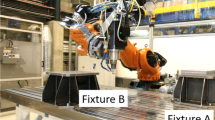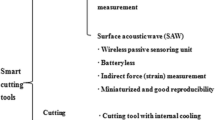Abstract
In this paper, a new desktop NC machine tool with compliance control capability is presented for finishing metallic molds with small curved surface. The NC machine tool consists of three single-axis robots. Tools attached to the tip of the z-axis are ball-end abrasive tools. The control system of the NC machine tool is composed of a force feedback loop, position feedback loop and position feed-forward loop. The force feedback loop controls the polishing force consisting of tool contact force and kinetic friction force. The position feedback loop controls the position in pick feed direction. Further, the position feed-forward loop leads the tool tip along cutter location data. In order to first confirm the application limit of a conventional industrial robot to a finishing task, we evaluate the backlash that causes the position inaccuracy at the tip of an abrasive tool, through a simple position/force measurement. Through a similar measurement and a surface following control experiment along a lens mold, the basic position/force controllability with high resolutions is demonstrated.
Similar content being viewed by others
Explore related subjects
Discover the latest articles, news and stories from top researchers in related subjects.References
Nakajima S (2006) Robotization of metallic mold polishing process (in Japanese). Plastics 57(12):39–42
Arai Y (2006) Robotic metal spinning: forming non-axisymmetric products using force control (in Japanese). J Robotics Jpn 24(1):140–145
Nagata F, Hase T, Haga Z, et al (2007) CAD/CAM-based position/force controller for a mold polishing robot. Mechatronics 17(4–5):207–216
Author information
Authors and Affiliations
Corresponding author
Additional information
This work was presented in part at the 13th International Symposium on Artificial Life and Robotics, Oita, Japan, January 31–February 2, 2008
About this article
Cite this article
Nagata, F., Hase, T., Haga, Z. et al. Intelligent desktop NC machine tool with compliant motion capability. Artif Life Robotics 13, 423–427 (2009). https://doi.org/10.1007/s10015-008-0567-8
Received:
Accepted:
Published:
Issue Date:
DOI: https://doi.org/10.1007/s10015-008-0567-8




